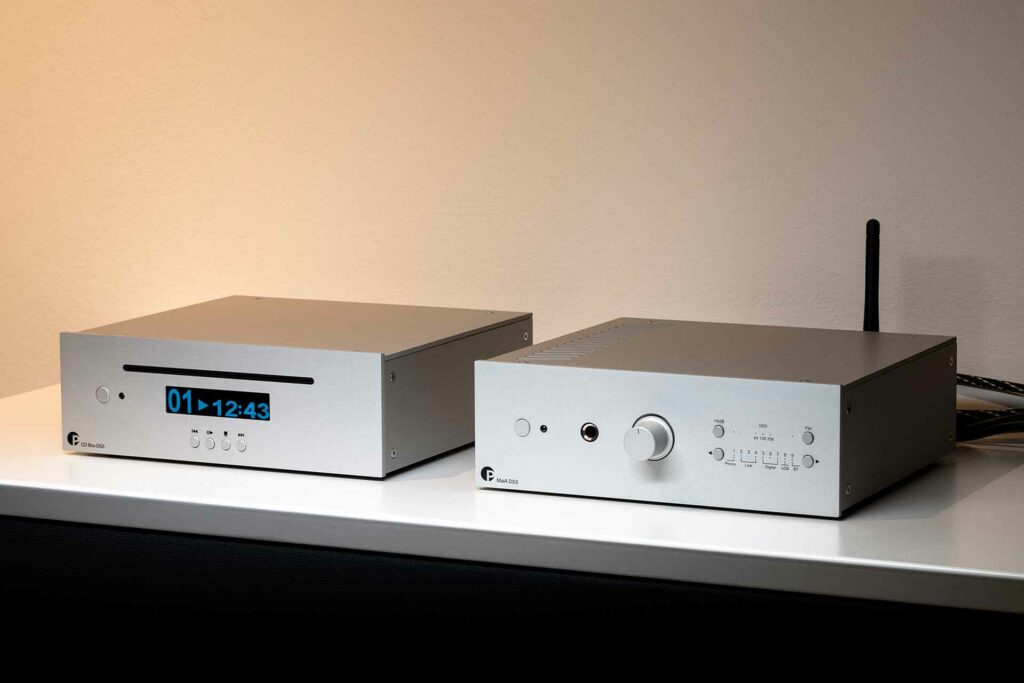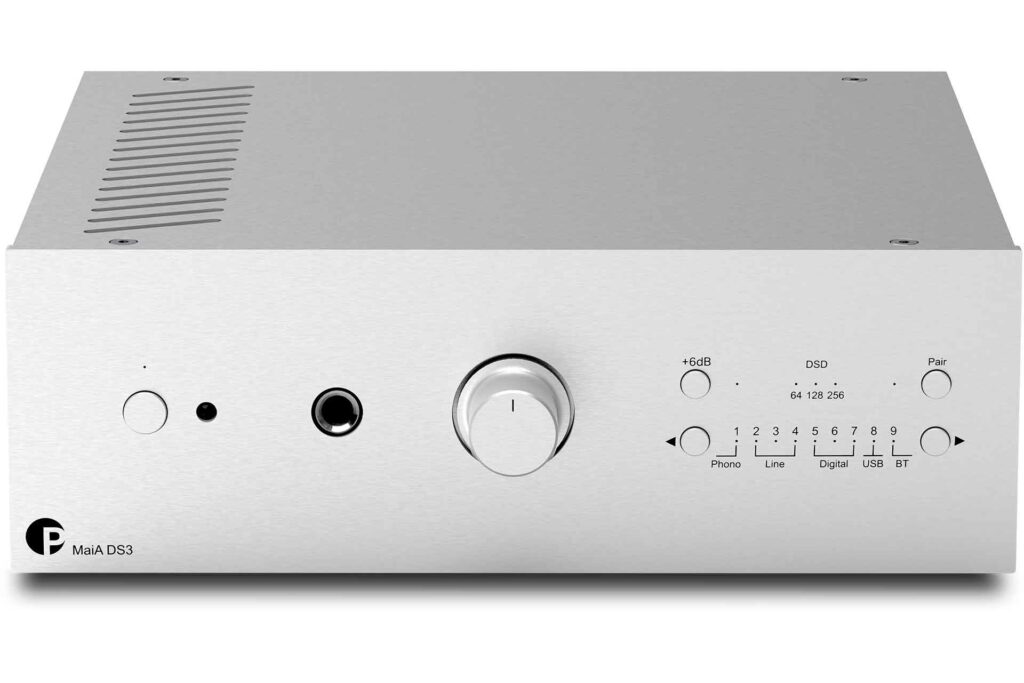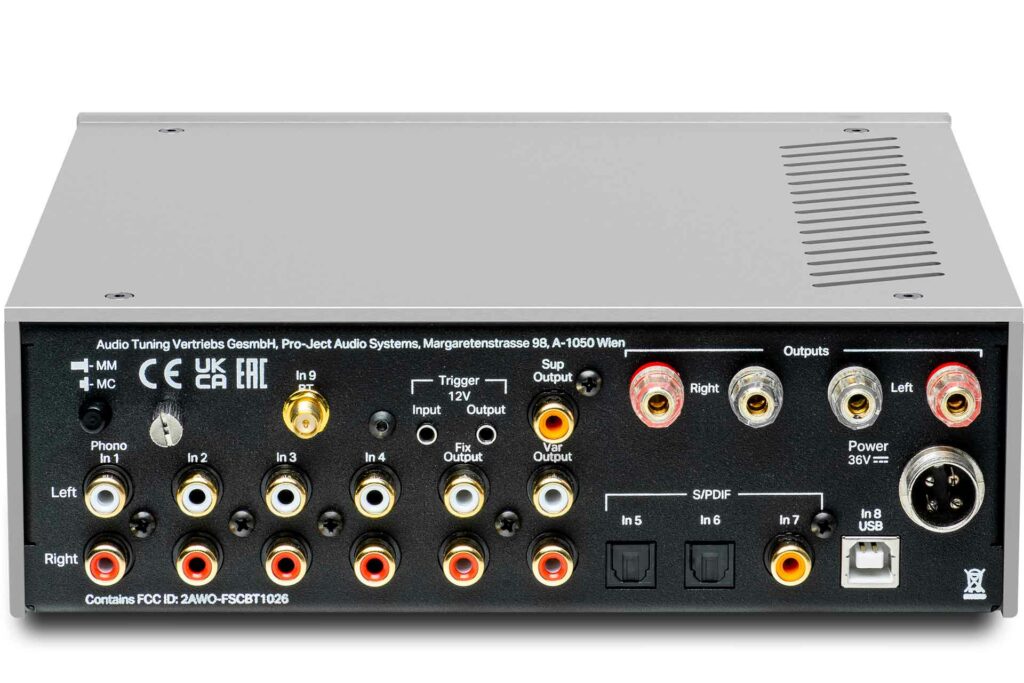An integrated amplifier doesn’t have to be physically large to be high performance and fully featured. When I read the initial press release for the Pro-Ject MaiA DS3 I thought, “There’s an amplifier that seems to fulfill all the requirements needed to be a really great integrated choice for a lot of audiophiles out there” and luckily I was able to get a review sample in short order.
The Pro-ject MaiA DS3 has both analog and digital inputs as well as a built-in headphone amplifier and phono preamplifier that supports both moving magnet and moving coil phono cartridges. In short, the MaiA DS3 can, in one modestly sized box, serve as a compact centerpiece of a high-performance audio system that can fit into the smallest space or desktop system and still deliver full-range high-fidelity sound. It even has a remote control.

What Makes the Pro-Ject MaiA DS3 Integrated Amplifier Special?
- With four single-ended RCA analog inputs, the MaiA DS3 can support good number of analog sources, including a turntable’s cartridge, FM tuner, tape deck, or other legacy sources.
- The MaiA DS3’s digital inputs include two Toslink, one coaxial S/PDIF, and one USB Type-B input, as well as Bluetooth 5.0 with aptX and AptX HD.
- With 80 watts per channel into 8 ohms and 140 watts into 4 ohms, the Pro-Ject MaiA DS3 is capable of driving most speakers with ease, even in a mid-sized room.
- The amp includes a dedicated subwoofer output so you can connect a subwoofer with one line-level cable instead of requiring a second set of speaker cables connected to the speaker connections.
- The inclusion of both a pair of fixed and variable line-level outputs increases the MaiA DS3’s flexibility and connectivity. You could add a second power amplifier, external headphone amplifier, or even connect to a second system in a separate room via these connections.
Why Should You Care About the Pro-Ject MaiA DS3 Integrated Amplifier?
Weighing only slightly over four pounds and measuring 8.11 x 2.8 x 9.45 inches, the MaiA DS3 is extremely compact, so it will fit into even small physical spaces easily. Even though it is physically compact, it has all the important connections required for a serious high-performance audio system, including subwoofer and headphone connections. The MaiA DS3 is an ideal solution for anyone who wants to assemble a serious audio system that occupies a minimal amount of space.

Some Things You Might Not Like About the Pro-Ject MaiA DS3
- To conserve space on the back, the MaiA DS3 uses miniature five-way binding posts that are, in reality, one-way speaker cable binding posts. Full-sized spade lugs do not fit. Bare wire proved to be equally problematic due to the tight space between posts and the ease of a stray wire shorting out the amplifier. The only safe connection methodology is via banana plugs. Don’t dare try anything else.
- While the volume control is easily located, since it’s smack dab in the middle of the front faceplate, it is a small knob and has no clicks or detents so there is no way to tell what the relative volume is. Yes, there is a small mark on the knob itself, but it could have been larger, a lot larger…
- Instead of a dedicated remote, the Pro-Ject MaiA DS3 uses a more universal Pro-Ject remote that is nearly as big as the entire front faceplate of the MaiA DS3 itself. The Pro-Ject remote has lots of buttons for functions not relevant to the MaiA DS3’s feature set.
- Rather than a standard IEC AC power connection, the MaiA DS3 uses an external power supply brick connected via a dedicated umbilical cord. While it is long enough for most applications, some users might require a longer or much shorter cable than the one supplied.
Listening to the Pro-Ject MaiA DS3 Integrated Amplifier…
There are times when a laid back, beautifully recorded piano trio is just what I want to hear. The Bill Charlap Trio performing “Autumn in New York” from Live at the Village Vanguard via Qobuz 44.1/16 FLAC ranks as a great example. The soundstage sounds wide, with each instrument occupying a very specific location. Dynamic contrast between the subtle cymbal brush strokes and the snare hits made this recording especially arresting on my nearfield system. Bill Charlap’s piano is big, dynamic, and when listening from the next room, sounds remarkably real. It also doesn’t hurt that these three jazzers can play their asses off.
Another live recording, with a much bigger crowd and more frenetic energy level, would be the previously available but newly remastered (just released on Qobuz and Tidal) release from Nickle Creek, Live from the Fox Theater. Originally recorded May 19, 2014, in Oakland California during their last reunion tour, Chris Thile, Sara and Sean Watkins, with Mark Schatz on bass are all in fine form. Recorded by Dave Sinko and remastered by Dave McNair, both the Qobuz and the Tidal 44.1/16 streams sound most excellent. The MaiA DS3 lets the aliveness of the recording come through. There are even several special vinyl versions also available for those who like to cuddle up to their music.
For a louder and more energetic track to test the MaiA S3DS3’s sonic mettle, try Little Feat’s Waiting for Columbus (Super Deluxe Edition) via Qobuz 96/24 FLAC. Not to be confused with the original Waiting for Columbus release, this new release has 6 CDs’ worth of live performances. With four versions of “Tripe Face Boogie” to shake rattle and roll with, the MaiA DS3 delivered enough slam coupled to the ATC SCM7 III and Velodyne DD10+ subwoofer to tripe anyone’s shorts, so to speak.
Does the Pro-Ject MaiA DS3 Integrated Amplifier Have Any Resale Value?
Yes, it likely will have good resale value. Pro-Ject is a well-distributed brand, including at Magnolia stores in North America, so there is some brand recognition, even outside of Pro-Ject’s normal vinyl stomping grounds. There’s good marketing behind the brand as well, but the full feature set and small size will likely be what draws in buyers on the secondary market.

Who Is the Competition For The Pro-Ject MaiA DS3 Integrated Amplifier?
$1,000 to $1,500 ranks as a sweet spot for integrated amplifiers. Amazon lists fifteen pages of options. I will include three. First is the Marantz PM8006 ($1,499 buy at Amazon). Since it’s housed in a full-sized 17-inch-wide chassis, there is room for real full-sized five-way binding posts. This Marantz includes all the input and output options of the MaiA DS3, except it only offers support for moving magnet phono cartridges instead of both moving coil and moving magnet like the MaiA DS3.
If you want an integrated amplifier that is tube-based rather than solid state, you might want to investigate the Vincent Audio SV-500 integrated amplifier ($1,200 buy at Amazon). It is another full-sized chassis with plenty of room for inputs and outputs. Unfortunately, it lacks a phono input and only has two digital inputs, Toslink and coaxial. But it does include a headphone output and has separate treble and bass adjustments.
If you want a Pro-Ject integrated, but can’t spring for $1,600, the company has another, similarly sized integrated offering, the Pro-Ject Stereo Box S2 ($1,099 buy at Amazon). It includes many of the features of the MaiA DS3, including both moving magnet and moving coil phono inputs, fixed and variable line-level outputs, and unfortunately those same micro-sized five-way speaker wire binding posts. But it does lack the USB-DAC input, as well as the coaxial and optical digital ins.
Final Thoughts on the Pro-Ject MaiA DS3 Integrated Amplifier…
As I mentioned earlier, if you are looking for an integrated amplifier priced around $1500, you have a plethora of options. The beauty of the Pro-Ject MaiA DS3 is that it includes all the inputs, outputs, and functions of a full-sized integrated amplifier in a compact package. Combine it with speakers such as the ATC SC7 III, or Sound Artist LS3/5a and perhaps a Monoprice SW-12 subwoofer, and you will have a near reference-quality system for far less than estate-level cost. The MaiA DS3’s inclusion of both moving magnet and a moving coil cartridge support means that when you upgrade your turntable’s cartridge from moving magnet to moving coil you won’t be forced to buy an external phono preamplifier to accommodate the upgrade. There’s an awful lot to like in a small box priced at an aspirational level here.




I’m going to seek out an audition of this amplifier. I’ve previously owned and enjoyed a Pro-ject turntable + phono pre that punched far above its price.
I know another reviewer who really liked this product too.
Let us know what you think when you get a demo.